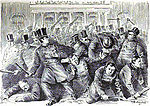Morse Building

The Morse Building, also known as the Nassau–Beekman Building and 140 Nassau Street, is a residential building in the Financial District of Manhattan in New York City, at the northeast corner of Nassau and Beekman Streets. The Morse Building, designed by Benjamin Silliman Jr. and James M. Farnsworth, contains elements of the Victorian Gothic, Neo-Grec, and Rundbogenstil style. The Morse Building uses polychrome brickwork and terracotta cladding to highlight its fenestration. Its interior structure consists of a steel frame placed upon a foundation that descends to an underlying layer of sand. The Morse Building was developed by G. Livingston and Sidney E. Morse, nephews of telegraph inventor Samuel F. B. Morse and sons of the site's previous owners. It was constructed from June 1878 to March 1880 and was one of the tallest buildings in New York City when completed, standing at 140 feet (43 m) with ten stories. As completed, the building had 175 offices and modern amenities such as steam heat and gas lighting. Bannister & Schell altered the building significantly in 1901–1902 to an Edwardian Neo-Classical style, bringing the building to 14 stories and 180 feet (55 m). Around 1965, the base was modified again and the balcony and cornice were removed. After a failed redevelopment attempt in the 1970s, it became a residential building in 1980, with 39 apartments. The building was designated a landmark by the New York City Landmarks Preservation Commission in 2006. The Morse Building is also a contributing property to the Fulton–Nassau Historic District, a National Register of Historic Places district created in 2005.
Excerpt from the Wikipedia article Morse Building (License: CC BY-SA 3.0, Authors, Images).Morse Building
Nassau Street, New York Manhattan
Geographical coordinates (GPS) Address External links Nearby Places Show on map
Geographical coordinates (GPS)
| Latitude | Longitude |
|---|---|
| N 40.7112 ° | E -74.0062 ° |
Address
Morse Building
Nassau Street
10038 New York, Manhattan
New York, United States
Open on Google Maps







